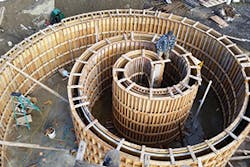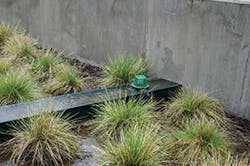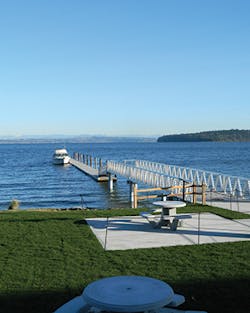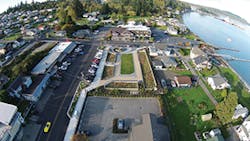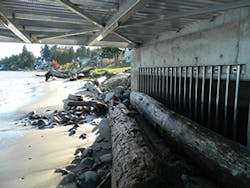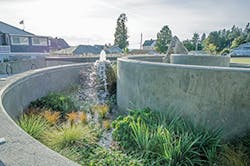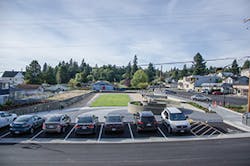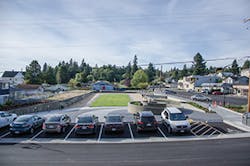Manchester’s Stormwater Park
The Puget Sound region is home to a wide variety of culturally and economically valuable wildlife including salmon, shellfish, and marine mammals. Many of these species are endangered or threatened, and all depend on clean water for healthy habitat. The region is also home to more than 4.4 million people who enjoy and appreciate the aesthetic and recreational opportunities that natural resources and clean water provide. The construction of the houses, roads, and businesses that all of these people rely on for their everyday needs has resulted in widespread coverage of impervious surfaces within critical drainage areas throughout the region. With an average of 3 to 4 feet of precipitation annually, these impervious surfaces generate enormous volumes of polluted urban stormwater, much of which flows to the Puget Sound without adequate treatment.
Urban stormwater runoff is one of the key sources of pollution impacting the health of the Puget Sound and the Salish Sea. The Puget Sound Partnership (PSP) is the regional agency tasked with coordinating restoration of Puget Sound water quality, and it has identified urban stormwater as the top priority for corrective action. The Washington Department of Ecology (WA-DOE) has also addressed reducing stormwater impacts through new stormwater management regulations under the current National Pollutant Discharge Elimination System (NPDES) permit, including an emphasis on low-impact development (LID) and green stormwater infrastructure. These new pollution and runoff flow-control standards have been developed to mitigate the impacts of new development and are expected to be a significant step toward protecting the Puget Sound from the impacts of future development.
However, there still remains the huge challenge of what to do about the legacy of existing development that has little to no stormwater treatment. By some estimates, about 90% of existing development in the Puget Sound region was constructed before the early 1990s when conventional stormwater management practices became more widespread in their application. Addressing the impacts of existing development remains a significant obstacle to the effective restoration of the Puget Sound ecosystem, as stormwater runoff and associated pollution from these older areas continues to have negative impacts on both freshwater and near-shore environments. One of the proposed solutions to the chronic problem of urban runoff and pollution from existing development is stormwater retrofits.
Retrofitting is the process of designing and implementing stormwater flow-control and water-quality treatment measures within the existing development footprint. Retrofits typically modify an existing, older collection and conveyance system by inserting treatment facilities where none were previously present. Because of the lack of available space in developed areas, utility conflicts, and the challenges of modifying existing drainage systems, retrofitting, especially in dense urban areas, is often problematic. Retrofitting existing development is typically much more costly than treating new development, so attaining good cost-to-benefit ratios can be challenging from both the engineering and the financing standpoint. As a result, successful stormwater retrofitting typically requires a combination of good engineering practice and opportunistic property purchase, as well as innovative thinking and the willingness to try new techniques.
Plantings in the bioretention swale
A Stormwater “Park” for Manchester
Kitsap County is located in the center of the Puget Sound and has many small- to medium-sized communities located along more than 200 miles of marine shoreline. Kitsap’s shoreline and maritime context has created a special identity for the people living there and a strong connection to the surrounding environment. In a pattern that is familiar to many urban shoreline areas, the area’s great livability factors have attracted significant growth and development. In the last two decades, this population growth, increased demands on existing storm drainage networks, and increased pollution from traffic and development have contributed to the degradation of local water quality and natural near-shore and stream habitat.
The environmental impacts for population increase and resultant urbanization led Kitsap County Public Works (KCPW) to develop integrated solutions to manage stormwater runoff. One of the main components of the overall stormwater management strategy is the use of green stormwater solutions (GSS) in retrofitting existing development. As in most of the Puget Sound region, much of the existing storm drainage infrastructure in Kitsap County is undersized and provides little or no water-quality treatment for stormwater runoff prior to discharge to the Puget Sound, especially in older communities and commercial centers. This is exactly the case in the community of Manchester.
The new pier
Manchester was settled in the early to mid-1800s as a logging, milling, and port town. It was also a regular stop for vessels of the Mosquito Fleet ferry system that provided transportation through out the Puget Sound. Manchester is currently a small community of about 5,000 people that sits on the east-facing slope of a steep hill that rises 400 feet above the Puget Sound. The “downtown” commercial core of the community lies at the foot of this slope along the shoreline. The Manchester Community Plan describes a vision of a rural village center that maintains Manchester’s small-town charm and quaintness while fostering economic development. The community is predominantly residential and is built on mostly small, sloped lots with little or no stormwater infrastructure.
In 2012, as part of a countywide effort to identify and prioritize potential stormwater retrofit projects, KCPW initiated the Manchester Community Stormwater Retrofit Plan study. Community-based stormwater retrofit plans were also developed for Silverdale, Kingston, Suquamish, Keyport, and several other areas of older, concentrated development. The Manchester retrofit plan identified as the top priority the Main Street-Colchester drainage basin, which is approximately 100 acres in size and includes the downtown commercial area, the most heavily traveled roads, and a significant portion of the community’s residential development. This drainage basin flows to a single outfall located on the beach at Pomeroy Park, one of the most popular recreational (for both swimming and boating) beaches in the county. Because of the lack of existing treatment facilities, this drainage basin was determined to be one of the highest-priority retrofit projects in Kitsap County.
The Manchester retrofit plan identified a wide range of options for retrofit projects, with an emphasis on GSS. More than 30 potential retrofit opportunities were identified, with the top three highest-ranking sites located in the Main Street-Colchester drainage basin. Because the Main-Colchester basin drained directly to the Puget Sound, only water-quality treatment was required (no flow control). It was therefore determined that the goal for the retrofit project should be to achieve full compliance with current stormwater water-quality treatment requirements for new development (the so-called 91% treatment standard), as well as meeting enhanced water-quality treatment objectives (i.e., removal of the target pollutants total suspended solids, metals, and PAHs). After preliminary engineering and hydro-geotechnical site assessments, it was determined that due to poor soils, high groundwater, and steep, unstable slopes, a network of distributed GSS treatment features would likely not be an optimum approach. Because the drainage basin flowed to a single outfall, a more centralized “end-of-pipe” treatment approach was evaluated.
One of the potential end-of-pipe retrofit sites identified in the Manchester retrofit plan was a 0.5-acre parcel located at the corner of Main Street and Colchester Avenue just uphill from the beach outfall. This vacant lot had been proposed for a multistory, mixed-use structure prior to the economic downturn, but had since gone undeveloped. As the project conceptual design evolved, Kitsap County saw a unique opportunity to treat a larger drainage area, maximize water-quality treatment, and correct some flooding issues while also creating a public open space in the center of the Manchester community. The KCPW design team began working on options for a water-quality treatment facility at this site, while simultaneously initiating possible property acquisition.
In evaluating options for stormwater water-quality treatment at the Main-Colchester site, both conventional and GSS alternatives were considered. Because of the small size of the available parcel, the relatively large contributing drainage area, and the high level of water-quality treatment desired, it soon became apparent that conventional pond, vault, or even sand-filter designs would not meet treatment goals. This pushed the design team toward a more innovative approach, which integrated both treatment requirements and preferred GSS techniques. Therefore, a GSS approach that used bioretention and tree-box filter design concepts soon became the preferred treatment method.
Concurrent with technical design development, the project team was also meeting frequently with the Manchester community to discuss options and solicit public feedback on the retrofit project. Not surprisingly, the community voiced their desire for a “context-sensitive” natural design that fit with the surrounding community’s character and took advantage of the Puget Sound views. An open-space “gathering” area was also of high interest to the community that would connect to and complement the existing waterfront Pomeroy Park. Education about stormwater, the Puget Sound, and how everyone can help improve environmental quality were also important messages the community wanted incorporated in interpretive signage for the stormwater facility.
Out of this integrated engineering design and community outreach process emerged the concept of a multiuse stormwater treatment facility and park as the preferred option. The only question was, just what was a “stormwater park”? After researching similar projects in Seattle, Portland, and elsewhere in the world, the project team began to flesh out the conceptual design for the Main-Colchester site. Property acquisition was completed in 2013, and design work moved forward with input from the Manchester community and other stakeholders, including the Port of Manchester, which owned the outfall property, and WA-DOE, which was helping to fund construction.
A multistory, mixed-use structure was once planned for the half-acre site.
Stormwater Park Design
With both treatment facility and community park elements, the design process was a marriage of both form and function. Runoff is collected, routed to the park, and treated using four interconnected GSS treatment cells prior to discharge into the Puget Sound. Polluted runoff enters the facility via the conveyance piping, where water pressure forces the untreated stormwater up into the 18 distribution channels that are positioned within the treatment cells to uniformly and simultaneously deliver the water into all four treatment cells that are located around the perimeter of the park. The treatment cells contain a proprietary high-capacity engineered filter media and plants that can tolerate periods of inundation while filtering the runoff to current Department of Ecology water-quality standard of 91%.
Stormwater runoff enters the channels from the inflow conveyance system and is distributed equally across each treatment cell. Stormwater infiltrates downward through the engineered filter media and is treated using filtration and absorption processes. The treatment cells are also planted with a diverse variety of plants that aid in the treatment process by uptake of pollutants and by mediating microbial degradation of other pollutants. These plants also provide aesthetic elements to the overall stormwater park design. Pollution, such as petroleum hydrocarbons, metals, nutrients, and pathogens, are removed from the runoff as it comes in contact with filter media and plants. The filter media has nearly limitless microscopic spaces so that pollutants can bind for many years to come without overloading the soil or leaching.
Treated water is collected in an underdrain system and subsequently discharged to the outfall at the beach. The system is designed to treat flows well exceeding 2,000 gallons per minute, equating to around 100 million gallons of polluted runoff treated annually. It is estimated that more than 100,000 pounds of contaminated suspended solids will be cleansed from the upstream stormwater runoff over the next 10 to 20 years.
Beach outfall
While the treatment mechanism is relatively simple in theory, the design of the treatment system is relatively complex. The innovation and engineering skill of the design team have created a stormwater treatment facility that is the right mix of form and function. The Manchester Stormwater Park should serve as a model for other Puget Sound shoreline communities with limited space for providing effective stormwater retrofit treatment.
A Twist on Rain Gardens: Going Spiral
A central design feature of the new park is a spiral rain garden. By “spiraling” this bioretention swale, the design team was able to provide the needed treatment capacity without using up valuable park area. At the same time, the spiral design evokes the nautilus shape that is associated with the marine environment of the Puget Sound. More than just an interesting aesthetic feature, the spiral rain garden is designed to help preserve the function of the larger treatment cells over time by ensuring the relatively constant low flows from groundwater and small storm events are diverted from the main treatment cells while still being filtered prior to discharge. These constant low flows could saturate the filter media within the larger treatment cells, which over time would result in standing water, reduced treatment, and additional operation and maintenance effort. The rain garden therefore provides a system to accept and treat groundwater and other low-flow storm events.
Valves control the distribution of the water to alternating zones of the spiral rain garden for flow distribution and optimal treatment. Bioretention soil mix and plants make up the treatment system, much in the same way a residential rain garden functions. As in the treatment cells, the treated water is collected in a lower drainage system and discharged to the beach outfall. Because the rain garden intercepts the constant low flows, the life of the more expensive engineered treatment media in the treatment cells will be extended and required maintenance efforts reduced. This combination of treatment cells and spiral rain garden will form a sustainable system for treating stormwater runoff for many years to come.
Meeting Project Challenges
Several critical project challenges were successfully addressed in addition to the technical challenges of designing Washington state’s first stormwater park. These challenges were associated with community relations and securing funding.
Nearly a decade ago, a proposed new saltwater outfall project in Manchester was abandoned after planning and design because of public opposition. The opposition focused mainly on aesthetics and impacts to the recreational activities of the area, as well as the lack of water-quality treatment in the proposed project. This historical community perspective set the stage for a challenging design and construction endeavor. A major accomplishment of the project was to transform this public concern, and in some cases opposition, into collaboration and support. This was accomplished by a thoughtful four-year process of community engagement that started with collaborative planning, was supported by consistent outreach, and concluded with a project that clearly reflected community desires and needs. Without this continuum of committed public communication and follow-up, the project could not have been completed.
The completed spiral rain garden
Kitsap County used a multiyear public involvement process to ensure community input and support. The process started with a design study that evaluated needs and options. Public involvement continued through construction, with multiple community meetings and updates. Careful attention was paid to up-front communication about potential project impacts, schedule, and contingency plans. Signage, website updates, onsite construction staff, and special community meetings were all used to communicate project issues and construction mitigation measures. This communication helped to ensure that the community and public concerns were considered in construction plans and were promptly addressed during construction activities.
Another major accomplishment for the project was securing significant external funding that was essential to meeting project budget needs. The project was first envisioned as a relatively simple outfall replacement. As the overall concept started to take shape, it was clear that while the park would provide a multitude of benefits, construction costs would significantly exceed available funding. Kitsap County therefore identified external competitive funding sources and applied for and received significant state grants for the project the following year. This external funding enabled both purchase of the park property and construction of the facility.
The park creates an open public space in the center of the community.
Stormwater Park Applications in the Puget Sound
There are numerous small, developed areas throughout the Puget Sound that could benefit from this approach to stormwater treatment. Typically, these older communities were built before the requirement for stormwater management, and therefore most have little or no water-quality treatment. Compounding this problem, most of these developed areas have little space available for conventional stormwater water-quality treatment systems. In some cases, small, distributed GSS techniques such as bioretention or permeable pavement are being used. However, in many locations similar to Manchester, poor soils, high groundwater, and/or steep, unstable slopes limit the applicability of infiltration-based GSS techniques. In these situations, our innovative end-of-pipe treatment system may be more appropriate and cost effective.
Flooding in Manchester during heavy winter rains has always been a problem. This project alleviates flooding by collecting runoff from the watershed upland from the stormwater park. The project also provides green stormwater solutions in the surrounding upland streets and residential areas, including rain gardens for bioretention within the street right of way.
The project also provided streetscape enhancements to the Manchester community center area. New diagonal parking on Colchester Drive is more efficient and safer for bicyclists and pedestrians. Bicycle racks have been installed at both the stormwater park and Pomeroy Park, and the parks are connected by a bike path and sidewalk on East Main Street. New pedestrian-scale lighting provides further connectivity between the parks. Improvements at Pomeroy Park include new pathways, grading, landscaping, accessible picnic tables, and a new non-motorized vessel pier.
The Manchester Stormwater Park demonstrates social, economic, and sustainable benefits for the community and the environment. The new park has enhanced the downtown area, providing clear social benefits for the community and economic benefits for local businesses. Located on a site that once housed a gas station but that had been a vacant lot for many years, it is now a public gathering space for the small community of Manchester, serving as a setting for Manchester Days, concerts, a farmers market, and outdoor movies. It is not only a pleasant community space but also a workhorse to clean polluted stormwater runoff from roads, parking lots, commercial property, and residential areas using green stormwater solutions. This project came about because an aging and undersized stormwater outfall pipe on the beach at Pomeroy Park needed to be replaced. Kitsap County took a holistic approach to the problem, and rather than just replace the outfall, sought a solution to address stormwater issues upland, improve water quality, alleviate flooding, and create a park for the community.
Funding for the project came from Kitsap County Public Works, Stormwater and Roads Divisions, and a grant from the Washington State Department of Ecology.
Resources
Project website: http://kitsap.paladinpanoramic.com/project/2231/44030
Project construction time-lapse video: https://vimeo.com/144919390
To access additional case studies and in-depth reporting, check out May edition of Stormwater.You may need to log-in or subscribe to our magazine.
